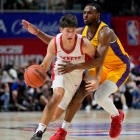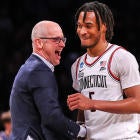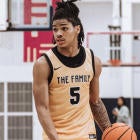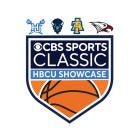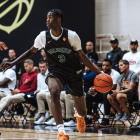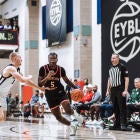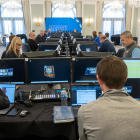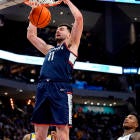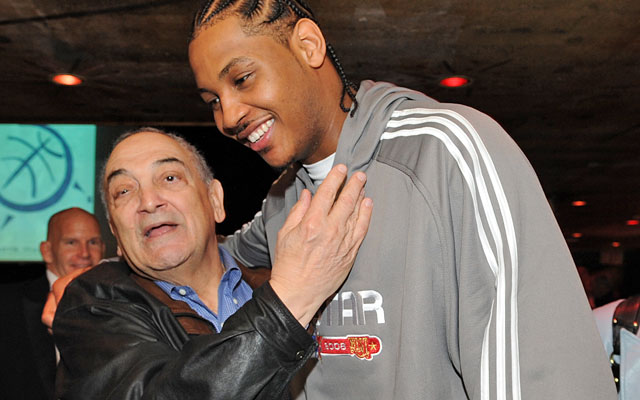
More from Solomon: O'Bannon timeline
The press conference on April 7, 2008, was portrayed as a great moment for the sport of basketball. The NCAA and NBA had decided to come together to try to clean up summer basketball. NCAA President Myles Brand, NBA Commissioner David Stern and other stakeholders in basketball -- college coaches, shoe company executives and AAU leaders -- sat at a podium at the Final Four to announce their efforts.
They talked about what would eventually become iHoops, a for-profit organization run by the NCAA and NBA. The idea: Improve youth basketball coaching and officiating, help the skills of players, promote team play, and screen summer coaches and tournaments.
Sonny Vaccaro, the former shoe marketer widely credited with inventing the summer basketball scene, seethed as he watched the news conference. No one, not even Vaccaro, could have imagined his anger from a Final Four news conference would result in the high-stakes Ed O’Bannon lawsuit scheduled for trial next week.
“That day convinced me that they are immoral because what they did -- in front of the world while they were applauded -- was say they were going to control 15-, 16- and 17-year-old kids who aren’t even in their system,” Vaccaro said. “Sure, it hurt, because it was everything they said I did, they were going to do to control these kids. They were going to put $50 million in a pot and create iHoops because they didn’t want them to go pro. I knew in my own mind: That’s antitrust. You can’t have professional and amateur controlling this group. The NCAA made the biggest mistake in their life that day, as far as I’m concerned.”
This is the story of how the O’Bannon lawsuit became a reality. It’s also the story of how Vaccaro -- love him or hate him, he’s the so-called “Godfather of Grassroots Hoops” -- turned one of his many crusades against the NCAA into something much different that has stuck for five years.
O’Bannon may be the public face of next week’s trial. But Vaccaro is the heart of it.
As the O’Bannon case over the commercial use of college athletes’ names, images and likenesses took twists and turns, it’s worth noting this was not the antitrust case Vaccaro initially had in mind five years ago. Now, the case in its current form could result in college athletes sharing licensing revenue, including the billions of dollars made from live TV broadcasts.
It’s quite possible some sort of O’Bannon lawsuit would have eventually happened. After all, even before iHoops, Vaccaro traveled to business and law schools at universities across the country speaking about his bitterness of the NCAA’s restrictions. He admittedly made those trips hoping he could persuade one law student to one day sue the NCAA.
But Vaccaro carries little doubt of the impact iHoops played on the O’Bannon lawsuit, which was filed in July 2009.
“That’s obviously what took me there,” Vaccaro said. “If there’s no iHoops, there’s no O’Bannon.”
Sonny goes to Washington
To be sure, there was some ego involved for Vaccaro regarding the 2008 Final Four summit to clean up the sport. Some of the biggest names connected to summer hoops were on the podium in San Antonio but no Vaccaro.
"Sure, that hurt when I saw (prominent AAU summer league organizer) Boo Williams and (Nike marketing official) George Raveling and (AAU president) Bobby Dodd up there,” Vaccaro said. “I was in David Stern’s office and he said are you going to the summit? I was never invited to the summit. Would you not have thought supposedly the smartest guy in the world who came up with all these things -- me -- would have been invited?”
At the press conference, Brand said the goal of the venture wasn’t to become a government agency, “but rather to, through the marketplace, develop what would play the role of a national organizing body.” In Vaccaro’s mind, he heard antitrust violations.
The iHoops initiative, which folded into USA Basketball in 2012, influenced Vaccaro to visit Washington D.C. in March 2009. There he met with Rep. Hank Johnson (D-Ga.), Rep. Steve Cohen (D-Tenn.) and Sen. Herb Kohl (D-Wisc). Kohl, the Milwaukee Bucks owner, was at the time chairman of the subcommittee on antitrust, competition policy and consumer rights.
Vaccaro said his purpose for the trip was to discuss possible antitrust violations over the age limit and iHoops’ emergence. During the visit, Vaccaro had dinner with longtime friend Rob Ades, a since-deceased Washington D.C. union lawyer who represented college basketball coaches such as Gary Williams, Jim Boeheim and Digger Phelps.
Ades had helped Vaccaro broker Nike’s first all-shoe deal for one university by landing Miami in 1988. Now in 2009, Ades was listening to Vaccaro’s crusade against the NCAA -- “he called me crazy,” Vaccaro said -- and the conversation turned toward another rant Vaccaro was making on his college speaking tour. Vaccaro believed college athletes were signing away their rights to the NCAA to post-college licensing money.
Ades told Vaccaro he would introduce him to a personal friend. Enter Ken Feinberg, who has administrated some of the largest and most difficult settlements and fund distributions in recent American history.
This is the mediator who, after only six weeks on the job, reached a $180 million settlement in an eight-year-old class-action by Vietnam veterans against the manufacturers of Agent Orange. This is the mediator who grimly administered nearly $7 billion to 9/11 victims as special master of the September 11th Victim Compensation Fund.
“I had no idea who he was,” Vaccaro said. “I mispronounced his name when he called.”
Recalled Feinberg: “I was very impressed with Sonny and his complaint. But I don’t represent class action, I don’t go to court. But I knew Michael Hausfeld was a nationally-known, class-action, antitrust litigator. I told Rob and Sonny that I’ll set you up with Hausfeld for a meeting, and Mike will be able to tell in a few hours if it’s worth going down the road.”
Feinberg’s name gave Vaccaro credibility in Washington. Hausfeld sent two lawyers for a meeting at a hotel in Santa Monica, Calif., near where Vaccaro lived. Vaccaro didn’t have much in the form of antitrust evidence. But he had boxes, he had theories and he had passion.
Aided by the organization from his wife Pam, Vaccaro had kept articles about perceived NCAA injustices for up to 40 years.
“For whatever reason, I was obsessed with all these things, and most of it started with the NCAA’s persecution of Jerry Tarkanian because I was involved in that on the exterior,” Vaccaro said. “My theory was why can a dozen people write about the NCAA injustices and nothing gets done? This is how O’Bannon started.”
Were the courts ready for O’Bannon?
Jon King was ecstatic to be one of the lawyers from Hausfeld’s Washington D.C.-based firm dispatched to meet with Vaccaro. King got the assignment in part because he was based in California, but also because he had a huge interest in college and pro sports. He grew up reading columns that Vaccaro wrote in The Basketball Times.
“For me, no matter what, it was going to be a hugely interesting meeting,” King said.
Very few people have had as much as influence on college basketball as we know it today as Vaccaro. It was Vaccaro who went to Nike chairman Phil Knight in 1978 with the idea of paying elite college coaches to have their teams wear Nike basketball shoes, making the players walking billboards for Nike and creating shoe wars with Adidas and Reebok.
By 1990, Nike was sending $4 million a year to 60 college coaches, including $200,000 to Georgetown’s John Thompson and $150,000 each to UNLV’s Tarkanian, Syracuse’s Boeheim and Arizona’s Lute Olson. Teams were receiving 150 pairs of shoes a year, plus clothing and gym bags. Nike was also funding the Nike-ABCD camp, summer leagues and the Dapper Dan Roundball Classic, the high school all-star event founded by Vaccaro.
For years, Vaccaro was accused of using his influence to help Nike-sponsored coaches recruit players who got free Nike equipment (or coaches sponsored by Reebok and Adidas, when Vaccaro later worked for those companies.) When Alonzo Mourning was off limits to college coaches under NCAA rules as the nation’s No. 1 prospect, there was Vaccaro taking him to lunch.
“It’s brainwashing,” Rebook director of marketing John Morgan, a former Nike boss of Vaccaro’s, told The Philadelphia Inquirer in 1990. “I think Sonny’s a great guy. In his heart, he’s trying to do the right thing. But it’s hard to believe you’re not influencing kids when you’re dropping $125 basketball shoes in their back yard.”
Said Vaccaro in a 1988 Washington Post article: “My dream when I went to Nike was that we'd own basketball -- I mean, at every level. I think I accomplished my goal without abusing the kids.”
When King met with Vaccaro in 2009, the lawyer was amazed at Vaccaro’s commitment and organization. Not only did Vaccaro keep so many articles and documents, he and his wife had spent their own money on his college trips to inspire the next generation to ask fundamental questions of the NCAA’s restraints on athletes.
“What was incredibly interesting is he made me pause and think what is the justification for a lot of things?” King said. “It was easy to figure out the lawyerly answers: ‘Well, the NCAA has been protected by the courts in certain kinds of cases and everybody has sort of accepted those kinds of answers.’ But the weaknesses in those answers revealed some options of taking those questions further. Sonny had fresh eyes and it was amazing, considering how deeply involved he was in the sports business.”
One document Vaccaro presented was a vague image release form athletes signed at the University of North Carolina.
“When you see that release and you’re looking at what appears to be the massive giving away of rights for forever, as an attorney you ask, 'Could that be legal?'” King said. “Is it going on at every school? Is it going on at the NCAA level?”
King said he had no initial doubts about Vaccaro’s complaints. The question: Were the courts ready for this suit?
“It seems like a millennium ago, but in 2009 we just didn’t have all these cases against the NCAA and all these issues,” King said. “Could these issues be set up for having a fair shake and even get into discovery? What we didn’t want to do is start it and get blown out of the box early on. That would deter others for ever challenging things for the next decade.”
Vaccaro convinced King the time was right by illustrating a few examples. One was the progress made by the National College Players Association under Ramogi Huma, who with help from the United Steelworkers led this year’s efforts by Northwestern football players to be declared employees by a regional director of the National Labor Relations Board.
Vaccaro also showed King articles with scathing language by an Ohio judge against the NCAA. In a February 2009 ruling involving the eligibility of Oklahoma State baseball player Andy Oliver, Erie County Judge Tygh Tone declared illegal a portion of the NCAA’s longstanding ban on athletes having agents during negotiations with professional teams. Tone appeared to have an eye beyond Oliver’s case when he wrote the NCAA’s ban on lawyers for athletes “was against the public policy of the State of Ohio as well as all states within this Union.”
King recalled telling himself, “'OK, there are some voices out there we can build on if we set things up in the right way.' There was enough there, it just hadn’t been brought together in the right form. Then the issue was, who would be the best front person for the case?”
Vaccaro was in Greece talking up his big initiative at the time -- he wanted more basketball players such as Brandon Jennings to skip one year of college and play in Europe due to the NBA’s age limit -- when Hausfeld called. He was interested in the antitrust case over athletes signing away their rights but needed the right plaintiffs. Vaccaro and his wife flew immediately from Athens to Washington.
Vaccaro said he called about 10 former players and only O’Bannon, the Most Outstanding Player of the 1995 Final Four for UCLA, was interested. The two initially met at Vaccaro's Roundball Classic in Pittsburgh, where O'Bannon was MVP his senior year of high school.
O’Bannon said he joined after seeing a friend’s child playing a video game featuring classic college teams. There was an avatar that looked like O’Bannon -- bald head, jersey number 31, left-handed shooter. The game didn’t identify O’Bannon by name and didn’t pay him, either. (O’Bannon is now scheduled to receive $15,000 in a settlement from EA Sports and Collegiate Licensing Company that must still be approved by the court.)
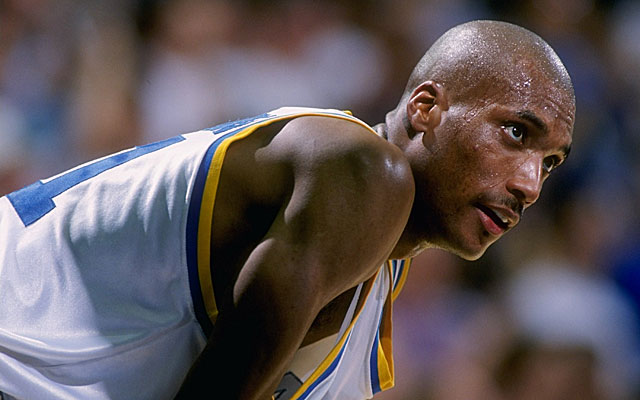
By landing O’Bannon, the class-action lawyers had someone “who was going to make this case about the issues and not about baggage in their background or distract in any way,” said King, who was fired by Hausfeld in 2012 and filed a wrongful termination suit that King later said in mediation was based on "incorrect" accusations. “Ed emerged into that role and contributed far better than anyone could foresee, except probably Sonny.”
NCAA and Vaccaro feud lives on
The theories of the O’Bannon case changed through the years. Initially the case focused on past licensing revenue, mainly video games, for former players. By August 2012, the case also turned to live broadcast money for current and future players.
“In 2009, I’m not sure anybody was ready for that type of case (with live broadcast claims), including us, because we didn't have the information,” King said. “We knew the restraint, but we didn’t have all of the facts to make the court fully understand what was going on.”
Back in 2009, Vaccaro was focused on the NCAA owing players money through EA Sports video games, jerseys, photos and rebroadcasts of classic games.
"I didn’t know about live broadcasts,” he said. “Obviously the money was big then, but after the suit was filed the money exploded. It is the most innocent beginning because it was never supposed to go this way. The irony is it could have been settled and dismissed if they had paid the players what they owed in classic sports [networks] and video games.”
Through the years, the bad blood between the NCAA and Vaccaro played out publicly. In court filings, NCAA attorneys used words like "agent," "runner" and "broker" to paint Vaccaro's livelihood coming off the backs of players.
The NCAA sought numerous documents from Vaccaro. At one point, the NCAA requested all of Vaccaro’s communications with New York Times columnist and frequent NCAA critic Joe Nocera, plus copies of every speech Vaccaro made over a seven-year period.
“Vaccaro and his organization are at the heart of decisions and financial careers of former student athletes,” the NCAA once wrote in O’Bannon court documents. “Vaccaro's participation in gathering plaintiffs is directly relevant to the merits of the claims as well as the qualifications of the class members.”
According to NCAA filings, ex-Michigan basketball player Eric Riley testified that his camp got money from Vaccaro’s foundation after being encouraged to join the suit, and ex-Connecticut basketball player Tate George received $3,000 from Vaccaro to change his mind and join the suit. (George withdrew as a plaintiff in 2013 after he was convicted of wire fraud.)
The O’Bannon plaintiffs countered by saying Riley testified that he decided to join the suit long before his mentoring program received Vaccaro’s donation, and George testified that his delay in joining was to analyze how it would affect his family, his standing at Connecticut and his position with the NBA Retired Players Association.
“(Former NBA player) Gary Payton told me at the All-Star Game that year to call Tate George, so I talked to him and some other guys,” Vaccaro said. “All I did was say, ‘This is what these lawyers are doing.’ The lawyers were looking for people too.”
Just last month, the NCAA sought to call Vaccaro to testify at the trial about his role in “recruiting” plaintiffs and suggested Vaccaro once made money off high school players’ name, image and likeness through his basketball camps. U.S. District Judge Claudia Wilken ruled that Vaccaro doesn’t have to appear because he has no relevant testimony to any disputed issues of fact in the case.
In a way, the latest spat between Vaccaro and the NCAA before trial seemed fitting. It brought the lawsuit full circle.
Before there was an O’Bannon case, the NBA and NCAA decided to clean up summer basketball and make money in the process.
Before there was an O’Bannon case, Vaccaro stewed at the thought of the NCAA and NBA profiting off players similar to what he had been accused of doing for so many years.
The rest is history that’s still being written.
“All these court cases against the NCAA since 2009 are because of O’Bannon,” Vaccaro said. “No matter what happens, we gave strength to others to sue these people.”









